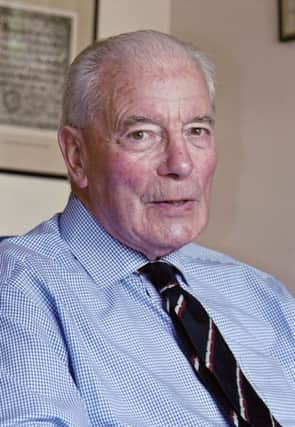Obituary: Air Commodore John Mitchell, Winston Churchill's personal navigator


In 1942, John Mitchell was selected to join the crew of Winston Churchill’s personal aircraft, the famous Avro York, named Ascalon – after the lance that St George used to slay the dragon. For two years Mitchell navigated “The Owner” – as Churchill was codenamed throughout the war – around the world from North Africa to Italy, the Middle East and Moscow. He also served the prime minister on more dangerous flights, to the Teheran and Yalta conferences. He flew “General Lyon” (the codename for King George VI) on several occasions as well, plus some of the leading military figures (including generals Alexander and Alanbrooke) and foreign dignitaries such as the South African Jan Smuts and Charles de Gaulle. With good reason it was named the VVIP Flight.
The Avro York was a huge, cumbersome bomber converted to incorporate all the modern communication systems along with smart sleeping arrangements and public accommodation for the passengers. Mitchell’s navigational quarters were adequate and he was able to house his equipment and plot the aircraft’s path, but the roar of the huge engines was relentless.
Advertisement
Hide AdAdvertisement
Hide AdMitchell co-wrote his memoirs (titled Churchill’s Navigator) in which he recounted several anecdotes about the war leader, for whom he had enormous respect. He told of one occasion when Churchill insisted on landing the aircraft himself – only for his stomach to get in the way of the control column, with near-disastrous consequences. The Avro York was later replaced by the more manageable (and more secure) Douglas C-54 Skymaster which the PM christened his “aerial yacht”.
Mitchell and the crew had to fly to Moscow to collect Mrs Churchill – greeting his wife on her return, the PM said to her: “I knew you would be safe with my boys.” The king was so impressed with the service provided by the crew that he later appointed them members of the Royal Victorian Order. Mitchell was appointed MVO (4th class), later upgraded to LVO.
The flying conditions were often challenging in the extreme and the maps on which Mitchell had to set a flight path provided minimum information. All flights to Moscow during the war had to fly via Cairo, so not only were they flying over hostile territory but via circuitous routes and with few navigational aids. Mitchell often had severe problems identifying the designated landing airfield.
Every trip was a complex security hazard and the crew were under severe pressure. Sarah Churchill in her book A Thread in the Tapestry tells of an occasion when her father had visited the 8th Army in Africa, but decided to return via Italy to visit the troops there. She wrote: “We had to land in Tunis and the wheels were already down. Suddenly the heavy York heaved itself up into the sky.” There had been a security alert and the York had to land elsewhere. The story demonstrates how vigilant Mitchell had to remain.
John Lewis Mitchell attended Bancroft’s School and initially worked for Customs and Excise before joining the RAFVR in 1939. On the outbreak of war he was trained as a navigator and commissioned into No 58 Squadron to fly Whitley bombers from an airfield near York. He flew many sorties over Germany in the first years of the war. Returning from an attack on Genoa, his aircraft ran out of fuel and the pilot had to ditch the plane off the coast of Kent. His squadron carried out many raids on German ports which disrupted their naval activities and in 1941 Mitchell was awarded the DFC.
After a period of researching celestial navigation in Canada, Mitchell’s experience as a navigator was brought to the attention of the authorities and he was transferred to serve on the VVIP Flight.
After the war, Mitchell was senior navigation instructor at Cranwell and then held a similar post at RAF Manby where he undertook long-range exercises over the North Pole in the converted Lincoln, Aries III. He became an authority on long-range trials including a round-the-world-flight. He remained at Cranwell as a senior instructor and on leaving Mitchell was awarded the AFC.
He continued to serve in politically hot locations – including Cyprus and Moscow during the Cold War – and in 1968 was director of air intelligence at the Ministry of Defence. He retired in 1974.
Advertisement
Hide AdAdvertisement
Hide AdSean Feast, who co-wrote Mitchell’s memoirs, has spoken warmly of their collaboration, saying: “John was a lovely man in every way, witty, charming and kind; a remarkable man and one of life’s characters.”
John Mitchell married Brenda Stroud in 1943. They had met when she was serving in MI5 and neither was able to tell the other what their job was. She died in 2000. Their two sons survive him.
Alasdair Steven